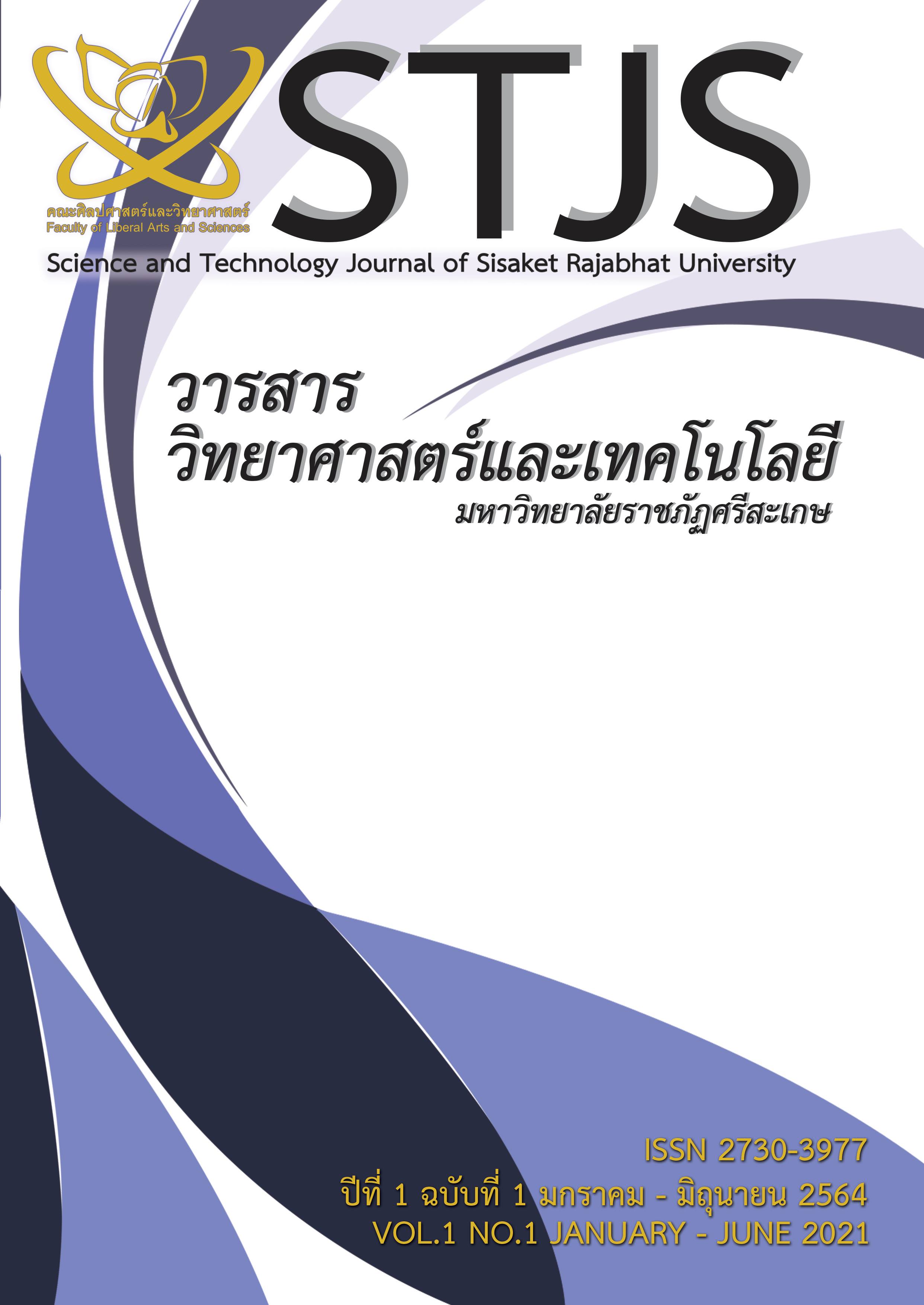Photocatalytic Activity of Glass-Ceramic Glaze for Fast Firing Ceramic Tiles
Main Article Content
Abstract
This research aims to study the additions of the TiO2 and the mixed TiO2/Al2O3 photocatalysts on the photocatalytic capability of the glass-ceramic glaze on the fast-firing ceramic tiles for developing the self-cleaning glass-ceramic glazed tiles without coating the TiO2 layer on the outer surface of the glazed-ceramic tiles. In addition, the self-cleaning glass-ceramic glazed tiles can reduce the manufacturing process and cost, while enhancing the utility and durability of the ceramic tiles. This work was conducted by studying the content and the particle size of the TiO2 and the mixed TiO2/Al2O3 photocatalysts, the firing temperature, and the firing rate on the photocatalytic capability of the glass-ceramic glaze on the fast-firing ceramic tiles prepared from glass frit raw material. The results of the study showed that adding solely TiO2 without Al2O3 in frit or glass-ceramic glazes were resulted in the transformation of TiO2 from anatase to rutile phase after firing at 1200 ºC, in which the photocatalytic activity was very low. Additionally, adding the mixed TiO2/Al2O3 (52/48 up to 48/52 by weight) in the frit glaze, no segregation of the single rutile TiO2 was observed. TiO2 reacted with BaO in the frit, and form barium titanium oxide (BaTiOx), which had better photocatalytic activity than rutile TiO2. The mixed TiO2/Al2O3 in frit glaze and firing at 1200ºC exhibited the degradation of methylene blue more than 44% from the continual test for 60 min.
Article Details

This work is licensed under a Creative Commons Attribution-NonCommercial-NoDerivatives 4.0 International License.
The content and information in the articles published in the Journal of Science and Technology, Sisaket Rajabhat University reflect the opinions and responsibilities of the respective authors. The editorial board of the journal does not necessarily agree with, nor share responsibility for, these views.
Articles, information, content, images, etc., published in the Journal of Science and Technology, Sisaket Rajabhat University are copyrighted by the Faculty of Science and Technology, Sisaket Rajabhat University. If any individual or organization wishes to republish all or part of the content, or use it for any other purpose, they must obtain written permission from the Journal of Science and Technology, Sisaket Rajabhat University beforehand.
References
Banerjee, S., Dionysiou, DD. And Pillai, SC. Self-cleaning applications of TiO2 by photo-induced hydrophilicity and photocatalysis. Applied Catalysis B: Environmental, 2015; 176–177: 396–428.
Murugan, K., Subasri, R., Rao, TN., Gandhi, AS., and Murty, BS. Synthesis, characterization and demonstration of self-cleaning TiO2 coatings on glass and glazed ceramic tiles. Progress in Organic Coatings, 2013; 76: 1756–1760.
Shen, W., Zhang, C., Li, Q., Zhang, W., Cao, L., and Ye, J. Preparation of titanium dioxide nano particle modified photocatalytic self-cleaning concrete. Journal of Cleaner Production, 2015; 87: 762-765.
Tezza, VB., Scarpato, M., Oliveira, LFS., and Bernardin, AM. Effect of firing temperature on the photocatalytic activity of anatase ceramic glazes. Powder Technology, 2015; 276: 60–65.
Celik, E., Keskin, I., Kayatekin, I., Azem, F., and Özkan, E. Al2O3–TiO2 thin films on glass substrate by sol–gel technique, Materials Characterization, 2007; 58, 349–357.
Mostaghimie, ME. Contreras-Garcia. Photocatalytic activity of Al2O3-doped TiO2 thin films activated with visible light on the bacteria Escherichia coli. Materials Science and Engineering B, 2010; 174: 74–79.
Barajas-Ledesma, E., Garcia-Benjume, ML., Espitia-Cabrera, I., Ortiz-Gutierrez, M., Espinoza-Beltran, FJ. Mostaghimie, J., and Contreras-Garcia, ME. Determination of the band gap of TiO2–Al2O3 films as a function of processing parameters. Materials Science and Engineering B, 2010; 174: 71–73.
Strnad, Z. Glass-Ceramic Materials. Elsevier Science Publishers Amsterdam: 9; 1986.
Manfredini, V. Ceramic tile glazes: design, trends and application. 7th Conference of the European Ceramic Society, 2001; 2031-2034.
Banijimali, S. Preparation of glass-ceramic glazes for fast firing applications by CaF2 substitution with B2O3 in the CaO-CaF2-Al2O3-SiO2 system. Ceramics International, 2013; 39: 8815-8822.
Casasola, R., Ma Rincon, J. and Romero, M. Glass-ceramic glazes for ceramic tiles: a review, Journal of Materials Science, 2012; 47: 553-582.
Midtdal, K., & Jelle, BP. Self-cleaning glazing products: A state-of-the-art review and future research pathways. Solar Energy Materials & Solar Cells, 2013; 109: 126-141.
Fujishima, A., Zhang, X., and Tryk, DA. TiO2 photocatalysis and related surface phenomena. Surface Science Reports, 2008; 63: 515–582.
ฉลาด บรรเทา และชูสิทธิ์ ศรีสุทธิกมล. กระบวนการโฟโตแคตาไลติก. 2548.
ชวิศร์ กรัณย์เมธากุล. การปรับแต่งผิวหน้าของไททาเนียมไดออกไซด์เพื่อปรับปรุงประสิทธิภาพในกระบวนการเร่งปฏิกิริยาด้วยแสง [วิทยานิพนธ์ปริญญาวิทยาศาสตรมหาบัณฑิต]. กรุงเทพมหานคร: สถาบันเทคโนโลยีพระจอมเกล้า พระนครเหนือ; 2549.
Surekha, K. & Sundararajan, S. “Self-cleaning glass” Anti-Abrasive Nanocoatings. Elsevier Ltd.: South Africa; 2015.
วรพงษ์ เทียมสอน. กระเบื้องเซรามิก เซรามิกเพื่อการก่อสร้าง และเซรามิคเพื่องานเทคนิค. กรุงเทพมหานคร: สำนักพิมพ์ โอเดียนสโตร์; 2555.
Hanaor, DAH. & Sorrell, CC. Review of the anatase to rutile phase transformation”. Journal of Materials Science, 2011; 46: 855–874.
Kumar, KNP., Keizer, K. and Burggraaf, AJ. Textural stability of titania-alumina composite membranes. Journal of Materials Chemistry, 1993; 3: 917-922.
Shirley, R., Inderwildi, OR. and Kraft, M. Electronic and optical properties of aluminium-doped anatase and rutile TiO2 from ab initio calculations. United Kingdom: Cambridge Centre for Computational Chemical Engineering, Department of Chemical Engineering, University of Cambridge; 2009.
Akhtar, MK. & Pratsinis SE. Dopants in vapor-phase synthesis of titania powders. Journal of the American Ceramic Society, 1992: 75; 3408-3416.


